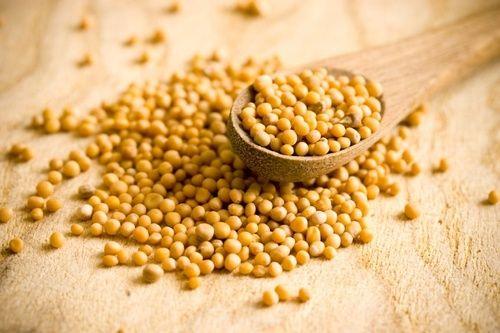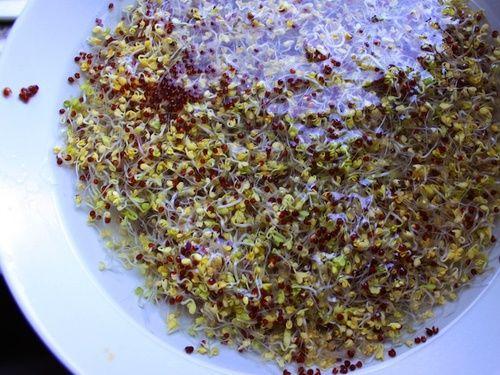With the term mustard we indicate some species of plants, belonging to the cruciferous family, originating in India and with a very ancient history. The seeds promote blood flow and are therefore useful for blood circulation, fever and cold. Let's find out better.
> The main nutrients of mustard seeds
> The properties
> Mustard seeds in the kitchen

The main nutrients of mustard seeds
Among the most common species of mustard we find:
- La white mustard (Sinapis alba), with the characteristic white / yellow seeds. The seeds of white mustard favor the preservation of food over time.
- La black mustard (Brassica nigra), the seeds of which are very dark, almost black. The flavor is particularly spicy.
- La brown mustard (Brassica juncea), with green seeds and very popular in the East.
- La wild mustard (Sinapis arvensis).
I mustard seeds they are oil seeds not excessively caloric (469 calories per 100 grams) and are source of minerals (calcium, magnesium, selenium, phosphorus, potassium, manganese) and vitamins.
Due to the presence of agglutinin they can be due to food allergy.
When you are talking about mustard in the gastronomic field it means the flour obtained from the crushing of mustard seeds (mainly of the white and black type).
You can learn more about the properties and uses of mustard sprouts

Property
Mustard has a similar effect to that of chilli, it can cause it iperemia (increased blood flow), irritation locally e inflammation of the digestive system, for this reason it must not be abused.
The sauces obtained with mustard seeds are excellent for giving flavor to dishes while maintaining a moderate caloric intake, therefore suitable for those who follow slimming diets.
Mustard seeds promote the flow of blood, for this they are an ancient natural remedy against many ailments:
- mustard seed flour poultices (sometimes mixed with flaxseed) are useful against rheumatism, arthritis e muscle pain.
- an infusion of mustard can help in case of colds and fever and stimulates the blood circulation.
- mustard seed oil is used in Ayurvedic medicine to practice anti-friction rheumatism e neuralgia.
Mustard seeds have always been known and loved all over the world: yes the Romans appreciated its medicinal properties (as well as the gastronomic ones) e for the Indians they are even a symbol of good luck, so much so that the doorsteps of the houses are sprinkled with mustard seed oil during celebrations and special occasions.
Also for Catholic culture mustard seeds have a symbolic meaning: represent the Church that starting from humble origins (such as those of these seeds) has spread all over the world.
In Eastern Europe, mustard seeds are combined with honey to combat coughs, while in Canada they are considered an excellent remedy for treating the ailments ofrespiratory system.
In France mustard is so popular that it was even established in the XNUMXth century guild of "mustards" in Orleans and later that of Dijon (another town famous for its renowned mustard sauces).
Mustard seeds in cooking
Le gastronomic preparations based on mustard (usually sauces and creams) are said mustards.
The term mustard comes from the Latin “mustum ardens” because the first sauces were made with mustard seeds and wine must. Even today in Sicily there are must-based mustards.
In el country when we talk about mustard we are referring to a typical dessert of the Christmas holidays: the mustard of Cremona. In our country, the focus was mainly on the preservative properties of mustard and the term mustard soon became synonymous with this Cremona dessert consisting of candied fruit in jelly (there are also vegetable-based variants) more or less spicy according to the quantity of mustard seeds.
In other kitchens instead, as in the French, German, Irish and Indian ones, mustard is the basis of many mustards with different flavors and more or less spicy that accompany meat, fish, cheeses, pickles and vegetables and flavor sandwiches.
The best known mustard sauce in the country is made from mustard seeds, vinegar, salt and water and tastes bitter and spicy at the same time, while that widespread in Anglo-Saxon countries it's a powder preparation of white and black seeds mixed with turmeric.
It seems that the invention of the mustard seed sauce dates back to the Middle Ages and is the work of French monks. The mustard became more aromatic over time, as new spices arrived from the East to add to the preparation such as pepper and cloves.
Its in France, mustard, boasts a great tradition: among the most valuable variants the "old-fashioned mustard"(Prepared with white and black seed flour) and the"Alsatian"(More delicate because with white seed flour only).
Also mustard leaves have a use in the kitchen: already in ancient Rome they were macerated in vinegar to obtain a tasty sauce and still today the leaves and flowering tops of this plant are used to enrich soups and vegetable creams.
| ameliaisland.com | Yummylaura.com


























